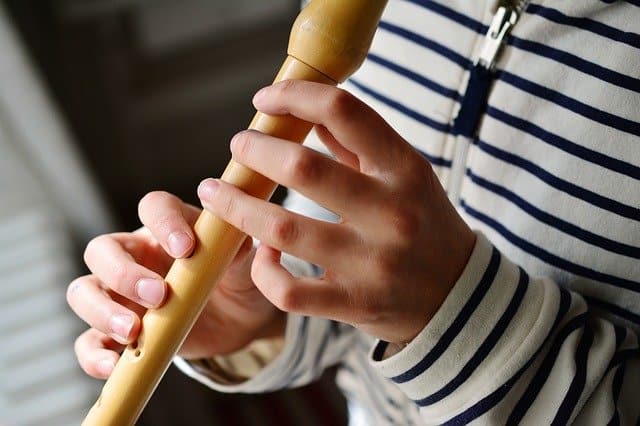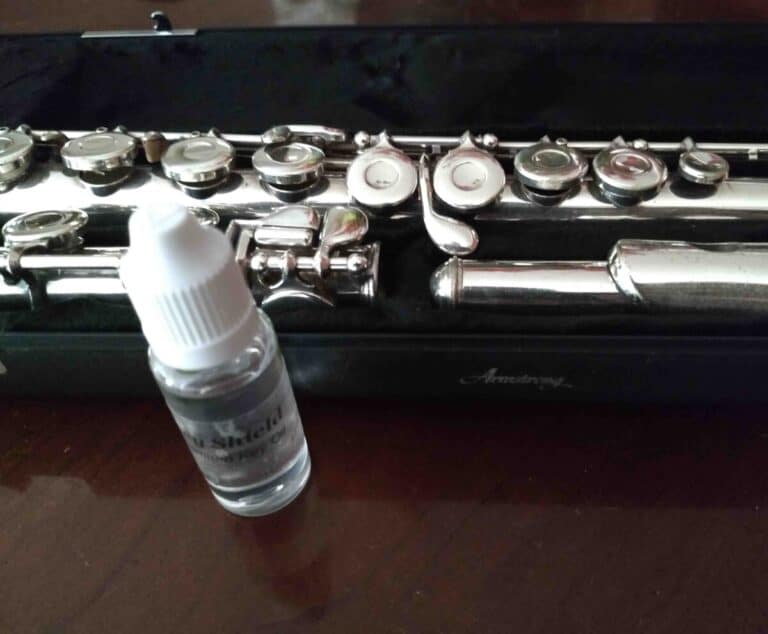How to Practice Flute Without Being Disruptive
It can be especially hard to find time and space to practice when your family and/or neighbors are not particularly keen on hearing you play. Fortunately, there are some techniques which you can use to practice flute without being too much of a disruption.
The easiest way to practice flute without being a disruption is to either practice in a space which absorbs sound or communicate with the people who might be bothered by your practice. One can additionally dampen the sound of the flute by placing sticky-tack on the back of the lip-plate. If all else fails, there are plenty of silent exercises on the flute which still make for productive practice.
| Solution | How to do it | Notes |
| Playing in a sound-absorbent area | Use a car if available, or clothes/padding on the walls of a room | Practicing in a car is the ideal solution; neighbors may hear you through soundproofing |
| Playing softly | Smaller opening of the lips, direct air downward | Unfortunately limits your dynamic range, making it less than ideal |
| Using sticky-tack | Place a small amount right behind the embouchure hole | Reduces tone quality and ease of playing, but is effective. Requires experimentation. |
| Silent practice | Finger through/visualize playing music | Not sustainable as a sole form of practice in the long run, but excellent as a temporary solution |
| Communication | Let your neighbors know what time you will typically be practicing at; have a feedback system | Many people are understanding if you are as transparent as possible |
Solution 1: Practicing in a space which absorbs sound
If you have a car, then you may find it worthwhile to use as a practice space. It is by no means a comfortable place to practice, but it is effective in that it dampens sound well and does not share any walls with neighbors who might become irritated. Not everyone has access to a car, however, and not everyone who does would be comfortable using it as a practice space. That being said, using a car is my top recommendation for a practice space if you are trying to avoid being disruptive
If you have to practice in an apartment which shares a wall with your neighbors, then you probably will not be able to find a space which dampens sound enough to make the flute quiet. It is probably worthwhile to use a space such as a closet – clothes naturally dampen sound to some extent. You may not be able to get away with shrill high notes this way, but it will at least reduce the distance that your sound travels to some extent.
There are also some easy and cost-effective things you can do to soundproof the room you are practicing in.
Basics of soundproofing
The idea here is that you are going to need to find a soft material to put over your walls. One option is clothes, but even bookshelves (filled with books) do a reasonable job at preventing sound from bleeding through. You will need something to hang clothes on if you choose to use them. I find that Command hooks work reasonably well.
My personal preference is to have real soundproofing material. These options take a little bit more money, but they are still reasonably easy to install. I recommend buying panels made of soft foam rubber, dense polyester fiber, or cork. Cardboard egg cartons make an effective budget option. You can use double sided tape or Command strips to attach them to your walls, and they should significantly cut down on the amount of sound which bleeds through.
Windows also allow sound to bleed a fair amount, but this shouldn’t be as much of a problem if you’re only using the room to practice flute. Your biggest concern should be walls that you share with a neighbor. Be sure to avoid choosing a room to practice in that has any shared walls, or at least make sure that you pad them.
Solution 2: Play softly
Playing softly is perhaps the most obvious solution. One way to accomplish this is to practice solely in the lower register of the flute – this tends to be quieter than the high notes. You can play more softly by keeping your lips closer together while playing and angling your air downward.
If you do this for the entire practice session, then it is less likely that your practice will be disruptive. Of course, this unfortunately means that you will not be able to practice with your full dynamic range, and you may struggle to hit high notes.
If you go through some effort to make sure that your practice space absorbs sound (see above) and you make sure to play softly, it is much more likely that you will be able to get away with practicing on a regular basis.
Solution 3: Sticky-tack
Sticky-tack (also called ‘blu tack’) is typically used to stick posters to walls, but we can use it to dampen the sound of the flute while still being able to practice normally. Place a small strip of sticky-tack on the back of the lip plate of your flute, just behind the tone hole. I use Play-Doh (a childrens’ toy), which is just as effective and can be seen in the picture at the top of this article. This trick temporarily messes up the acoustics of the flute, rendering it unable to produce any substantial sound.
You may need to experiment with the exact position of the sticky-tack in order for this to be effective. Depending on the placement, you might find that your flute no longer produces any sound, or that the dampening effect isn’t there. That’s fine; you can just move the sticky-tack, try playing your flute again, and continue adjusting as needed.
I found that the best position for the sticky-tack (or Play-Doh) is when it is perfectly aligned with the back edge of the embouchure hole, but is not hanging over. Again, this can be seen in the picture at the top of this article.
The result of this should be that the sound of the flute is reduced to a mere whisper, even in the upper register. In fact, you will likely find that there is a lot of resistance especially in the upper register. One drawback to this is that it becomes difficult to assess whether or not you are using the correct embouchure for high notes or low notes, as the flute overall becomes difficult to produce sound on. This is perhaps not the best technique for practicing harmonics.
You will also likely find that your tone quality is worse overall when you are using this trick. You will still need to find time to practice long-tones without the sticky-tack if you want to continue to get better. Nonetheless, this technique allows you to practice a wide variety of things without being a disruption.
There is a possibility that some of the sticky-tack will get caught inside the flute, and that you will have a difficult time getting it out completely. You shouldn’t be putting the sticky-tack inside the flute (just on the edge of the embouchure hole), but I nonetheless recommend you use this technique with caution.
Solution 4: Use silent practice techniques
You do not necessarily need to play the flute in order to practice it. There are plenty of ways to practice the flute silently, and these techniques may be useful to you if you are concerned about being disruptive.
Technique 1: Fingering through scales
Practicing scales is necessary for every flutist, and fortunately you can practice them without making any sound at all. The technique is simple: have your flute out and play through your scales, but simply don’t blow any air into your flute. This is relatively easy to do, won’t disturb your family or neighbors, and will still be just as helpful as if you had actually been playing the scales. My recommendation is to have your flute out and finger through your scales as you are watching a TV show or video – this doubles as an easy way to make practice enjoyable.
Technique 2: Visualization exercises
It is possible to practice flute not only without making any sound, but without having a flute at all. You can do this with either scales or with full pieces of music.
Suppose that you are trying to memorize a scale, such as the C major scale. You can accomplish this relatively easily through visualization. Start by imagining the position of each finger as you play a low C. Don’t actually move your fingers (though you may feel the desire to); just imagine pressing each finger onto the correct key to play a low C. Then imagine lifting your right pinky, to play a low D. Follow that by imagining yourself lifting your right ring finger to play a low E, and so on.
You can do this for passages of music as well. If you have a difficult passage of sixteenth notes, imagine yourself fingering each note of the passage one at a time. Imagine what it feels like to press each individual key, as well what it feels like to transition to each note of the passage (whether that involves pressing keys, lifting keys, or both). This technique can help you memorize music quickly and learn to play it well.
I find that both of these techniques (fingering scales and visualization exercises) are effective when I need to learn music without making any noise. You will still need to find time and space for other exercises (such as long tones, etc.), but silent techniques make a good start to having a non-disruptive flute practice.
Solution 5: Communication
If you are continuously unable to find time to practice in a way that is not disruptive and you are dissatisfied by the above solutions, your best bet is to go talk to the people who you might be disrupting. It is possible that they will be completely fine with your practice if you ask in the right way and take measures to avoid being a burden.
First, you should aim to have a consistent time at which you practice; this will make it easier for your neighbors to get used to it. Hearing a loud instrument is more jarring if it is unexpected, and being consistent will help you to avoid this problem.
Make sure your neighbors know what time you will be practicing at. Have some kind of system that allows them to inform you if you are being too loud. For instance, consider telling them that they can knock on your shared wall if the noise starts to bother them (and that you will knock back to let them know you heard it). Aside from being polite, this also ensures that your neighbors will bring any complaints to you rather than the police.
Finally, try to avoid using techniques which are excessively garish if you are going to be practicing in a space where others can hear you. If you are going to be flutter tonguing for your entire practice session, for instance, consider trying to find a time when you won’t risk being disruptive instead. At the very least, ask your neighbors if they are alright with that kind of practice.
Many people will be understanding if you simply inform them of what you will be doing in advance and give them the opportunity to have their concerns with it be addressed. With proper communication, you will likely not have to soundproof your room or spend the entire time playing quietly.
Conclusion
Admittedly, it can be difficult to find the time, place, and circumstances to practice without bothering other people. Even though the flute can be a loud instrument, I firmly believe that nobody should have to give it up (or avoid learning it) purely for the sake of appeasing those around them.
Even if you live in circumstances that make it difficult to find time to practice on a regular basis, my hope is that the above tips give you the best possible chance at practicing in a way which doesn’t bother other people. If there is any way that you can make it work, then it is well worth it for the sake of practicing a wonderful instrument.






